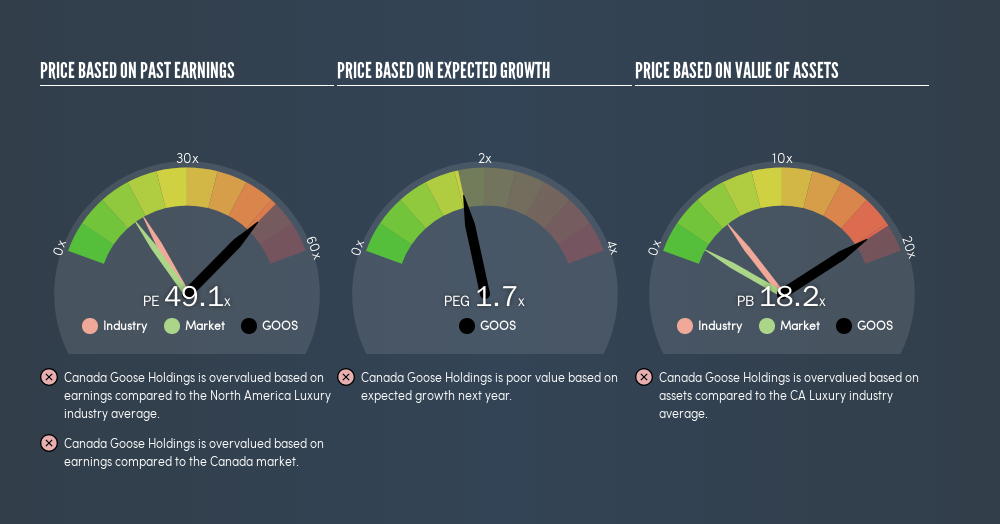Here's What Canada Goose Holdings Inc.'s (TSE:GOOS) P/E Is Telling Us

This article is written for those who want to get better at using price to earnings ratios (P/E ratios). We'll apply a basic P/E ratio analysis to Canada Goose Holdings Inc.'s (TSE:GOOS), to help you decide if the stock is worth further research. Canada Goose Holdings has a price to earnings ratio of 49.1, based on the last twelve months. That is equivalent to an earnings yield of about 2.0%.
Want to participate in a short research study? Help shape the future of investing tools and you could win a $250 gift card!
See our latest analysis for Canada Goose Holdings
How Do You Calculate A P/E Ratio?
The formula for P/E is:
Price to Earnings Ratio = Price per Share ÷ Earnings per Share (EPS)
Or for Canada Goose Holdings:
P/E of 49.1 = CA$64.3 ÷ CA$1.31 (Based on the trailing twelve months to December 2018.)
Is A High Price-to-Earnings Ratio Good?
A higher P/E ratio implies that investors pay a higher price for the earning power of the business. All else being equal, it's better to pay a low price -- but as Warren Buffett said, 'It's far better to buy a wonderful company at a fair price than a fair company at a wonderful price.'
How Growth Rates Impact P/E Ratios
Generally speaking the rate of earnings growth has a profound impact on a company's P/E multiple. When earnings grow, the 'E' increases, over time. That means even if the current P/E is high, it will reduce over time if the share price stays flat. A lower P/E should indicate the stock is cheap relative to others -- and that may attract buyers.
In the last year, Canada Goose Holdings grew EPS like Taylor Swift grew her fan base back in 2010; the 114% gain was both fast and well deserved. Even better, EPS is up 70% per year over three years. So we'd absolutely expect it to have a relatively high P/E ratio.
Does Canada Goose Holdings Have A Relatively High Or Low P/E For Its Industry?
The P/E ratio essentially measures market expectations of a company. As you can see below, Canada Goose Holdings has a higher P/E than the average company (17.4) in the luxury industry.

That means that the market expects Canada Goose Holdings will outperform other companies in its industry. Clearly the market expects growth, but it isn't guaranteed. So further research is always essential. I often monitor director buying and selling.
Remember: P/E Ratios Don't Consider The Balance Sheet
One drawback of using a P/E ratio is that it considers market capitalization, but not the balance sheet. So it won't reflect the advantage of cash, or disadvantage of debt. Hypothetically, a company could reduce its future P/E ratio by spending its cash (or taking on debt) to achieve higher earnings.
Spending on growth might be good or bad a few years later, but the point is that the P/E ratio does not account for the option (or lack thereof).
Is Debt Impacting Canada Goose Holdings's P/E?
Canada Goose Holdings's net debt is 0.6% of its market cap. It would probably trade on a higher P/E ratio if it had a lot of cash, but I doubt it is having a big impact.
The Verdict On Canada Goose Holdings's P/E Ratio
Canada Goose Holdings has a P/E of 49.1. That's significantly higher than the average in the CA market, which is 14.8. While the company does use modest debt, its recent earnings growth is superb. So to be frank we are not surprised it has a high P/E ratio.
Investors have an opportunity when market expectations about a stock are wrong. If the reality for a company is better than it expects, you can make money by buying and holding for the long term. So this free visualization of the analyst consensus on future earnings could help you make the right decision about whether to buy, sell, or hold.
But note: Canada Goose Holdings may not be the best stock to buy. So take a peek at this free list of interesting companies with strong recent earnings growth (and a P/E ratio below 20).
We aim to bring you long-term focused research analysis driven by fundamental data. Note that our analysis may not factor in the latest price-sensitive company announcements or qualitative material.
If you spot an error that warrants correction, please contact the editor at editorial-team@simplywallst.com. This article by Simply Wall St is general in nature. It does not constitute a recommendation to buy or sell any stock, and does not take account of your objectives, or your financial situation. Simply Wall St has no position in the stocks mentioned. Thank you for reading.
About TSX:GOOS
Canada Goose Holdings
Designs, manufactures, and sells performance luxury apparel for men, women, youth, children, and babies in Canada, the United States, Greater China, rest of the Asia Pacific, Europe, the Middle East, and Africa.
Acceptable track record with mediocre balance sheet.


